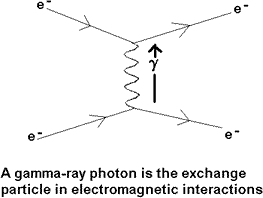Exchange Particles When interaction between particles occurs there is a change in the energy state of each particle eg. one gains energy the other loses it. We know that mass and energy are interchangeable, we can therefore consider an 'exchange particle' going from one to the other. When we detect a particle it interacts with our detector! Therefore if we detected the exchange particle it would not be acting as an exchange particle any more but have come out of the system... that is why we can call exchange particles virtual... if they did more than exchange energy/mass/charge they would not be exchange particles at all.
This diagram was part of the AQA teacher material when the topic of Particle Physics was first introduced to A Level students back in the 1990s. The pion was initially considered to be the exchange particle for the strong force because it fitted with the quark exchange involved but that has now been amended in the light of recent work and the exchange particle for the strong force is now known as the gluon. This is an illustration of how examination boards adapt to new findings.... But it does mean that old examination questions will expect you to say that the exchange particle for the strong nuclear force is the muon, whereas new questions will expect you to say gluon.
Click here to see an animation of this. The gravitational
force has 'gravitons' as the exchange particles and the weak
nuclear force has 'w-bosons'.
|
Follow me...
|







